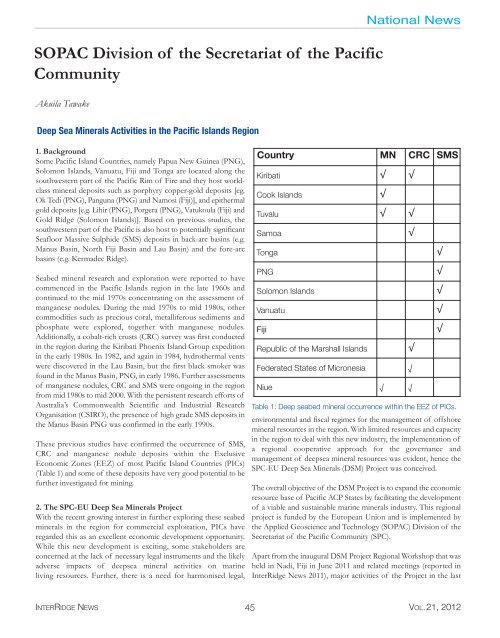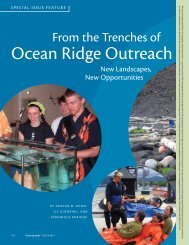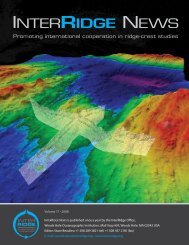Full version, low resolution, 7.5MB - InterRidge
Full version, low resolution, 7.5MB - InterRidge
Full version, low resolution, 7.5MB - InterRidge
Create successful ePaper yourself
Turn your PDF publications into a flip-book with our unique Google optimized e-Paper software.
SOPAC Division of the Secretariat of the Pacific<br />
Community<br />
Akuila Tawake<br />
National News<br />
Deep Sea Minerals Activities in the Pacific Islands Region<br />
1. Background<br />
Some Pacific Island Countries, namely Papua New Guinea (PNG),<br />
Solomon Islands, Vanuatu, Fiji and Tonga are located along the<br />
southwestern part of the Pacific Rim of Fire and they host worldclass<br />
mineral deposits such as porphyry copper-gold deposits [eg.<br />
Ok Tedi (PNG), Panguna (PNG) and Namosi (Fiji)], and epithermal<br />
gold deposits [e.g. Lihir (PNG), Porgera (PNG), Vatukoula (Fiji) and<br />
Gold Ridge (Solomon Islands)]. Based on previous studies, the<br />
southwestern part of the Pacific is also host to potentially significant<br />
Seafloor Massive Sulphide (SMS) deposits in back-arc basins (e.g.<br />
Manus Basin, North Fiji Basin and Lau Basin) and the fore-arc<br />
basins (e.g. Kermadec Ridge).<br />
Seabed mineral research and exploration were reported to have<br />
commenced in the Pacific Islands region in the late 1960s and<br />
continued to the mid 1970s concentrating on the assessment of<br />
manganese nodules. During the mid 1970s to mid 1980s, other<br />
commodities such as precious coral, metalliferous sediments and<br />
phosphate were explored, together with manganese nodules.<br />
Additionally, a cobalt-rich crusts (CRC) survey was first conducted<br />
in the region during the Kiribati Phoenix Island Group expedition<br />
in the early 1980s. In 1982, and again in 1984, hydrothermal vents<br />
were discovered in the Lau Basin, but the first black smoker was<br />
found in the Manus Basin, PNG, in early 1986. Further assessments<br />
of manganese nodules, CRC and SMS were ongoing in the region<br />
from mid 1980s to mid 2000. With the persistent research efforts of<br />
Australia’s Commonwealth Scientific and Industrial Research<br />
Organisation (CSIRO), the presence of high grade SMS deposits in<br />
the Manus Basin PNG was confirmed in the early 1990s.<br />
These previous studies have confirmed the occurrence of SMS,<br />
CRC and manganese nodule deposits within the Exclusive<br />
Economic Zones (EEZ) of most Pacific Island Countries (PICs)<br />
(Table 1) and some of these deposits have very good potential to be<br />
further investigated for mining.<br />
2. The SPC-EU Deep Sea Minerals Project<br />
With the recent growing interest in further exploring these seabed<br />
minerals in the region for commercial exploitation, PICs have<br />
regarded this as an excellent economic development opportunity.<br />
While this new development is exciting, some stakeholders are<br />
concerned at the lack of necessary legal instruments and the likely<br />
adverse impacts of deepsea mineral activities on marine<br />
living resources. Further, there is a need for harmonised legal,<br />
Country MN CRC SMS<br />
Kiribati √ √<br />
Cook Islands<br />
Tuvalu √ √<br />
Samoa<br />
Tonga<br />
PNG<br />
Solomon Islands<br />
Vanuatu<br />
Fiji<br />
Republic of the Marshall Islands<br />
Federated States of Micronesia<br />
Niue √ √<br />
Table 1: Deep seabed mineral occurrence within the EEZ of PICs.<br />
environmental and fiscal regimes for the management of offshore<br />
mineral resources in the region. With limited resources and capacity<br />
in the region to deal with this new industry, the implementation of<br />
a regional cooperative approach for the governance and<br />
management of deepsea mineral resources was evident, hence the<br />
SPC-EU Deep Sea Minerals (DSM) Project was conceived.<br />
The overall objective of the DSM Project is to expand the economic<br />
resource base of Pacific ACP States by facilitating the development<br />
of a viable and sustainable marine minerals industry. This regional<br />
project is funded by the European Union and is implemented by<br />
the Applied Geoscience and Technology (SOPAC) Division of the<br />
Secretariat of the Pacific Community (SPC).<br />
Apart from the inaugural DSM Project Regional Workshop that was<br />
held in Nadi, Fiji in June 2011 and related meetings (reported in<br />
<strong>InterRidge</strong> News 2011), major activities of the Project in the last<br />
√<br />
√<br />
√<br />
√<br />
√<br />
√<br />
√<br />
√<br />
√<br />
INTERRIDGE NEWS 45 VOL.21, 2012
















